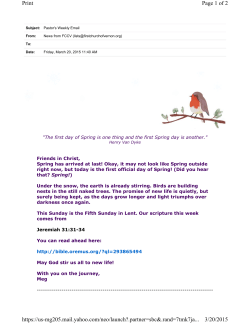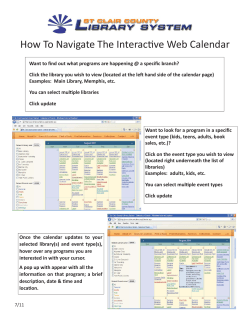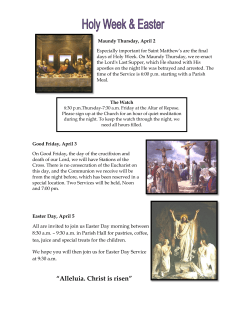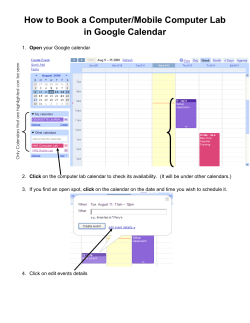
Friar Galen of Ockham, MC, OP
The Computus Digitorum Presenting a Period method of Discerning the Date of Easter, and a Modern Tool to determine the Canonical Hours and Construct a Personal Liturgical Calendar for these Current Middle Ages Friar Galen of Ockham, MC, OP July AS XXXIX Table of Contents Introduction ..................................................................................................................... 1 The Roman Calendar ........................................................................................................ 1 Roman Inclusive Counting ................................................................................................ 1 Division of the Roman Month............................................................................................ 1 Leap Year ......................................................................................................................... 2 The New Year ................................................................................................................... 2 The Date of Easter ............................................................................................................ 2 Calculating Easter from the Tables ............................................................................... 3 Calendar Fragment for Calculating the Date of Easter 1900 - 2099 A.D. ............................ 4 The Fixed Feasts .............................................................................................................. 5 The Movable Feasts .......................................................................................................... 6 The Division of the Day..................................................................................................... 6 Computus Digitorum version 1 ........................................................................................... 8 Essential References ....................................................................................................... 10 Other Helpful References ................................................................................................ 10 i Galen of Ockham ii The Computus Digitorum T his project began in the mid-1990s as an investigation into the Canonical Hours. As with most projects, it didn’t stop there, but expanded to include a general Liturgical Calendar. Next I added the Roman Calendar notation. I had included the table of the Golden Numbers early on, but they were essentially cosmetic, so I had to find out exactly what they had been used for in period. Extrapolating from there, I developed a technique of determining the date of Easter from the Golden Numbers and made them truly functional. The goal then for this calendar is to develop a method of constructing a medieval-style Liturgical calendar for the current modern year that the medievalist can feel a connection to the Middle Ages in form, but maintain modern observances. I believe I have accomplished this by providing a computerized method to remove the tedium of calendar building, but maintaining the flexibility to customize the calendar for personal beliefs and practices. Herein lies the fruits of my research – this documentation of the Medieval Roman Liturgical Calendar in general, and the Excel calendar spreadsheet in specific. A note on the term Computus Digitorum. I came across this phrase in an abstract discussing the Venerable Bede’s book de temporum ratione (The Reckoning of Time). The computus (Latin: computation) is the technique for calculating the date of Easter, or, more generally, for techniques used in developing a calendar. Bede referred to a method of calculating using his fingers, the computus digitorum. I thought this was an appropriate pun in our modern world of digital computers and thus adopted the name for my computerized calendar. This document and the computerized version are works in progress. I appreciate comments on how you found it useful or problems you’ve encountered. The Roman Calendar The calendar utilized in western Europe during the middle ages was not the universally standardized version we enjoy today. The uniting structure was the major festivals of the Church. Some of these celebrations occurred on fixed dates such as St. John the Baptist or Christmas, while others occurred relative to the movable date of Easter (such as Pentecost). Dates were commonly referred to by their Church festival rather than the familiar month/day/year used in modern times. It was also quite common to see documents with the dates given in the style used in the ancient Roman empire. The calendar used in the middle ages in lands that had been in contact with the Romans was developed for Julius Caesar and enacted in 46 BC, and known to us by his name – the Julian Calendar. The Romans set year 1 of their calendar to glorify the founding of Rome in 753 BC. Years counted under this system were referred to as “from the founding of the city,” ab urbe condita (AUC). In antiquity the Romans had used year lengths of 10, 11, and 12 months, but by the fall of the Empire the calendar had settled into 12 months with each month having the same number of days as we are familiar with in the 21st century. Roman Inclusive Counting Before looking closer at the Roman calendar, there is a quirk of Roman counting that is essential to understanding their system. The Romans used “inclusive” counting which counts both the beginning and ending points, unlike the way we would count in modern times. Using this system, the number of days between dates is one more than the way we would count it. For example, tomorrow would be the second day from now – today=1, tomorrow=2. Have you ever been confused by the Easter story of Jesus being 3 days in the tomb? In modern times we would consider Friday evening to Sunday morning to be a day and a half, or two if you were being generous. However, using the Roman method, you would count Friday as day one, Saturday as day two, and Sunday as the third day. Division of the Roman Month The month in the Julian calendar was divided into irregular segments, likely to have originally been connected with the phases of the moon. The first day of the month is the Kalends and originally occurred at the new moon. The name comes from the Latin calere – “to call” as the pontifex would “call out” the announcement of the new month as signaled by 1 Galen of Ockham the sighting of the moon just past new. The next division was the Nones occurring 9 days prior to the Ides and fell on the 5th or 7th of the month. The Ides represented the full moon. The name is derived from iduare – to divide. The Ides is the 15th of the month in March, May, July, and October, and the 13th in January, February, April, June, August, September, November, and December. The remaining days of the month are counted as the number of days before the next Kalends, Nones, or Ides (counting inclusively) and are labeled, e.g. ante diem III Kalends Martius which would be the 28th of February in a leap year. The day before the Kalends, Nones, or Ides is pridie (e.g. pridie Kalends Martius – the last day of February). Roman Months Insert Roman names of months Leap Year A problem that has plagued all calendar systems is there aren’t an even number of lunar months in a solar year. This causes the calendar dates to drift in relation to the seasons. Julius Caesar attempted to fix this drift by adding an extra day to every 4th year to give an average of 365.25 days per year. This was much closer to the actual length of year of 365.2422 days. This slowed the drift of the seasons, but over several centuries it became obvious the dates in the calendar were shifting through the seasons. Pope Gregory XIII instituted a more refined system in 1582 that we are still using in our Modern Middle Ages. Leap years occur every 4th year except century years divisible by 400 (e.g., 1600 and 2000). This brings the average days per year to 365.2425 – very close to the actual 365.2422. The actual leap day is inserted after a. d. VI kalendis Martias (24 Feb) and called bis a. d. VI kalendis Martias, and is the origin of the term bissextile to describe a leap year. The New Year Even though Dionysius Exiguus defined year one of the calendar when he developed his tables of Easter in the early 6th century, there was still a lot of confusion as to the actual date when the new year started: “If we suppose a traveler to set out from Venice on 1 March 1245, the first day of the Venetian year, he would find himself in 1244 when he reached Florence: and if after a short stay he went on to Pisa, the year 1246 would already have begun there. Continuing his journey westward, he would find himself again in 1245 when he entered Province, and on arriving in France before Easter (16 April) he would be once more in 1244.” Cheney p 8. The starting points of the calendar that have been used include Christmas, the Annunciation (March 25), Easter, and January first. Christmas Day makes sense since a year numbered based on the birth of Jesus would start on the date celebrated as his birthday. It was used in various locations as late as 14th century. The Annunciation is also called “Lady Day” and was commonly considered the start of the new year in England until the Gregorian calendar was adopted in British lands in 1752. Some areas were one off on the starting year and used dates one year earlier than other locations. Easter Day was used in some parts of France. What goes around, comes around, as January 1 was historically used by the Romans and was recommended for use by both Dionysius and Pope Gregory XIII. It was formally adopted in England with the change to the Gregorian calendar. 2 The Computus Digitorum The Date of Easter Though details are sketchy, the date of Easter was declared by the Council of Nicea as having to be on a Sunday, rather than on whatever day of the week the Jewish Passover fell on. This was further clarified by Dionyisius Exiguus with the tables he published in 525 AD. Easter was then defined as the first Sunday following the first full moon following the vernal (spring) equinox. These landmarks are not the astronomical ones that you would see if you were looking at the spring sky, but were set mathematically. The vernal equinox was defined as 21 March, whereas astronomically it can occur on 20 or 21 March. The full moon is likewise a calculated value. The earliest possible date for Easter is 22 March and the latest 18 April. There is a simple formula to determine the date of Easter, however, this is not period. The period method was to have professional astronomers build tables of the dates of Easter. The method they used is fairly straightforward. The ancients recognized that the cycles of the phases of the moon and the seasons didn't completely agree. [Insert details on Meton]. The Metonic cycle is19 years in which the lunar cycle of 13 months a year and the solar cycle of 12 months a year come together. The position of the current year in the Metonic cycle is called the Golden Number. It can be calculated by: Golden Number = 1 + MOD(Year,19) Where MOD means divide Y by 19 and throw away everything but the remainder. Thus 2004 would be MOD(2004,19) = 9 (2004 divided by 19 equals 105 remainder 9) 9 + 1 =10 therefore 2004 has a Golden Number of 10. Similarly, 2005 has a Golden Number of 11. Most medieval calendars include a column containing Roman numerals. This serves as a lunar almanac. The Roman numerals represent the date of the calculated new moons for a year with that Golden number. For example, February 28 has the number iv next to it, therefore it is considered a new moon date in years with a Golden number of 4. 3 Galen of Ockham Calendar Fragment for Calculating the Date of Calculating Easter from the Tables The attached calendar fragment is for useful for calculating the date of Easter for the years 1900 – 2099 AD. First, look at March 21. This is the date that is defined as the Vernal Equinox for the purpose of Easter calculations and is labeled in blue on in the Computus Digitorum. Using 2007 as an example, The Dominical Letter after the leap day is G (labeled in red), which means any date with a G by it is a Sunday. The Golden number is 13, so any date on the chart with an xiii by it is the calculated (not actual) new moon. The Paschal New Moon will be the new moon closest to the Equinox (occurs in the range 9 March – 5 April). Referring to the calendar excerpt, the Paschal new moon is on March 19 (again marked in red). The full moon following that will be 14 days later (or 15 days if you are using inclusive counting), 2 April (outlined in red). This is a Monday (day letter A). Easter would then be the next Sunday (letter G), 8 April. March Equinox The table of Golden Numbers used in the Computus Digitorum was developed by first shifting the table from the Julian calendar as used in period to the Gregorian calendar used in Catholic Europe since 1582 and England (and the Colonies) since 1752. The numbers were hand-tweaked by comparing the numerically-calculated date of Easter with the tablecalculated version until harmony was reached. April Easter 4 8 xiv 9 10 11 12 13 14 15 16 17 18 19 20 21 22 23 24 25 26 27 28 29 30 31 1 2 3 4 5 6 7 8 9 10 11 12 13 14 15 16 17 18 iii xi xix viii xvi v xiii ii x xviii vii xv iv xii i ix xvii vi xiv iii xi xix viii xvi v xiii E F G A B C D E F G A B C D E F G A B C D E F G A B C D E F G A B C D E F G A B C vii Ides vi Ides v Ides iv Ides iii Ides prid. Ides Ides xvii Kal xvi Kal xv Kal xiv Kal xiii Kal xii Kal xi Kal x Kal ix Kal viii Kal vii Kal vi Kal v Kal iv Kal iii Kal Prid. Kal Kalends iv Nones iii Nones prid. Nones Nones viii Ides vii Ides vi Ides v Ides iv Ides iii Ides prid. Ides Ides xviii Kal xvii Kal xvi Kal xv Kal xiv Kal The Computus Digitorum The Liturgical Year Advent Christmas Epiphany Lent Eastertide Pentecost Common time The Movable Feasts Several of the major celebrations of the Church are based on the date of Easter. The first of these is Ash Wednesday which marks the beginning of the Lenten season. It occurs 46 days prior to Easter. This gives 40 days of Lent, since the six Sundays aren’t considered to be a part of Lent. Shrove Tuesday is the day prior to Ash Wednesday and was the last day meat products were allowed before Easter, thus the term carnival (Latin carne vale), which means “goodbye meat.” Next comes Palm Sunday which ushers in Holy Week. This is the Sunday before Easter. The days of Holy Week are Holy Monday, Holy Tuesday, Holy Wednesday, Maundy Thursday, Good Friday, and Holy Saturday. The next day is Easter, beginning the Octave of Easter (Easter Sunday through the Sunday after). The Ascension is 10 days before Whitsunday (Pentecost), which is 49 days after Easter (50 if you use inclusive counting). The week following Whitsunday is Trinity Sunday. The feast of Corpus Christi (not the town in Texas) is 12 days (inclusive) after Trinity Sunday. Other movable dates that don’t depend directly on Easter are the four Sundays before Christmas which mark the beginning of the Christian year with the season of Advent. Ember days are times of special prayers for each season and are the Wednesday, Friday, and Saturday after Ash Wednesday, after Whitsunday, after the Exaltation of the Cross (14 September), and after St. Lucia (13 December). Rogation days are days of fasting and prayer to appease God’s anger with man’s transgressions. They are the Major Rogation day on April 25, and the minor Rogation days the three day prior to the Feast of the Ascension. The Fixed Feasts Like many facets of medieval society, the feasts celebrated by the Church had a lot of room for variation, when properly approved by the local bishop, of course. The main outline of the festivals of the year were standard, but many of the minor saints’ day celebrations varied by region or country. Especially favored were saints that had a connection to the local area. The dates I’ve chosen heavily follow English usage. I’ve attempted to use the date for the celebration as used in the middle ages, unless it is also a well-known modern date. In making a calendar for your own use, you can of course include any saints or celebrations that fit your persona or modern preferences. Hagiography A hagiography is a book or listing of Saints. I use it here in conjunction with feasts which occur on a fixed date to discuss the Feasts I have chosen to include in this version of The Computus Digitorum. January 1 6 The Circumcision of our Lord Epiphany 5 Galen of Ockham February Xx March Xx April Xx May Xx June Xx July Xx August Xx September Xx October Xx November Xx December Xx Liturgical Colors White Red Green Violet Black Rose Blue 6 The Computus Digitorum The Division of the Day The monastic day was divided into at least seven times of prayer as called for in Psalm 119:164: “Seven times a day I have given praise to thee, for the judgments of thy justice.” The actual times of the services varied widely due to local custom, the monastic order, and the actual length of the day and night. The divisions of the day were not the uniform hours we use today. The period from sunrise to sunset was divided into 12 equal hours as was the period from sunset to sunrise. Therefore, a day hour was a different length than a night hour. The length of an hour also varied season-to-season, especially in northern Europe. The hours were numbered starting with the first hour at sunrise, on through the 11th hour just before sunset. The hours of the night started at sunset. Thus noon was the sixth hour of the day. This system can be seen in the King James version of the Bible from 1611. Mechanical timepieces were not commonly available until the mid to late 1400s and since they were more adept at keeping a uniform hour the equal hour slowly came to be the dominant form of timekeeping (hours “of the clock” or o’clock). Though some of the Canonical hours were combined or moved to give the monks more time to sleep (especially during the short winter nights of northern Europe), I have adopted a system of Hours spaced every three unequal hours. Keeping the tradition of the ancients, the day began at sunset. The first of the Canonical Hours, at sunset, was Vespers. Compline was the prayer time before bed and is halfway between Vespers and midnight. At the midpoint of the night comes Matins. Halfway from midnight to dawn is Lauds, which in period was often combined with Matins (which gives seven periods of prayer). Sunrise marks the first hour of the daytime, thus the name Prime (Latin for first). The beginning of the third hour of the day (halfway from sunrise to noon) is Terce (from the Latin for third). Noon is the sixth hour of the day, therefore Sext was the noontime prayer. Mid-afternoon brought None (the ninth hour). This brings us back to Vespers. Computus Digitorum calculates the time of sunrise and sunset for each day and uses the length of the day and night to calculate the unequal hours. The Canonical Hours are then calculated and the modern clock time for each of the Offices is given for each day. The calendar correctly corrects for daylight saving time as implemented in the United States. 7 Galen of Ockham Computus Digitorum version 1 The Computus Digitorum Excel spread sheet has been under development for over 7 years. I serendipitously found a routine that calculates sun rise and set times, immediately removing the major tedium from preparing the calendar. This enticed me to work to further automate it. In approximately 24 hours, the calendar transformed from almost complete manual entry to almost complete automation. Of course, I’ve spent many more hours tweaking and documenting the Calendar. Nota bene: You must have Excel’s Analysis ToolPak Add-in installed. This can be found on the Tools…Add-Ins menu. If Analysis ToolPak doesn’t have a check mark by it, check it and hit OK then follow the instructions. You may need the install disk. What's calculated automatically: 1. Modern Calendar Date (column A) 2. The day of the week (column B) 3. The Golden Number (column D), used to determine Paschal New Moon 4. The Dominical Letter (column E, Sunday highlighted in red) 5. Roman-style date (column F) 6. Times for stylized Canonical Hours (columns H - O) 7. Sunrise, sunset, length of night and day, length of unequal hours (columns P - U) 8. The Canonical Hours evenly spaced as described above. 9. Properly adjusts for US Daylight Saving Time 10. Leap years are handled appropriately 11. The date of the Paschal New Moon (red, bold, italic Roman numeral in column D in March or April) 12. Date of the Paschal Full Moon (red box in column D in March or April, 13 days after Paschal New Moon). The Sunday following this date is Easter. Calculated, but not automatically placed into calendar: 1. Date of Easter (Location and Movable Feasts sheets) 2. Dates of other movable feasts based on date of Easter Items that still have to be entered manually: 1. The Saint's days, feasts, and liturgical colors in column G 2. Lunar phases (column C) To fill in the Calendar: 1. Set the correct year in the location tab. 2. Move any of the fixed feasts that fall on Sunday to the following Monday (except Christmas). Use Copy/Paste rather than Cut/Paste (messes with formatting). Consider marking feast as “transferred”. 3. Put in the movable feasts, moving any fixed feasts one day later if necessary (Don't move feasts for Ember or Rogation days). 4. Label the Sundays in January prior to Epiphany as Sundays after Christmas (white). 5. Common days prior to Epiphany are white. 6. Common days from Epiphany to Ash Wednesday are green. 7. The first Sunday after Epiphany is the Baptism of Christ (white). 8. Remaining Sundays prior to Ash Wednesday are “Nth Sunday after Epiphany”. The Sunday just prior to Ash Wednesday is “Last Sunday after Epiphany”. All are green. 9. Starting with Ash Wednesday, common days are purple 10. Sundays in Lent are “Nth Sunday in Lent” up to Palm Sunday. They are purple. 11. Palm Sunday through Holy Saturday are red or purple. Good Friday may be black. 12. Easter through Pentecost is white. 13. The Sunday after Easter is the “Second Sunday of Easter” and numbered sequentially through the Sunday before Pentecost. 14. Pentecost is red. 15. Common days and Sundays after Pentecost are green. This season goes all the way to Advent. 16. The Sunday after Pentecost is Trinity Sunday (white). 8 The Computus Digitorum 17. Sundays after Trinity Sunday start with “Second Sunday after Pentecost” and are numbered in sequence. 18. The last Sunday in Advent is Christ the King (white). 19. Common days and Sundays in Advent are Purple. Advent III may use pink. 20. Christmas to the end of the year is white. This is the first public release of Computus Digitorum and it has not been thoroughly tested for all years in the valid period nor on a wide variety of computers or versions of Excel. The dates of Easter and its graphic calculation have been verified from 1900 – 2099. The routine to mathematically calculate Easter dies outside this period. The program was developed on Excel 2000 (9.0.2720). I would appreciate feedback on any problems and other comments or suggestions. 9 Galen of Ockham Essential References Bede: The Reckoning of Time. Translated by Faith Wallis. Liverpool University Press – Translated Texts for Historians. 1999. Blackburn, Bonnie and Leofranc Holford-Strevens. The Oxford Companion to the Year: An Exploration of Calendar Customs and Time-Reckoning. Oxford University Press. 1999. Cheney, C.R. (ed), Revised by Michael Jones. A Handbook of Dates for Students of British History, New Edition. Cambridge University Press. 2000. Ottewell, Guy. Astronomical Calendar. Department of Physics, Furman University. Annual editions. Pedersen, Olaf. The Ecclesiasical Calendar and the Life of the Church. in Gregorian Reform of the Calendar: Proceedings of the Vatican Conference to Commemorate its 400th Anniversary 1582 – 1982, eds G.V. Coyne, S.J.M.A. Hoskin, and O. Pedersen. Specola Vaticana. Ciffa sel Vaticano. 1983. Richards, E.G. Mapping Time: The Calendar and its History. Oxford University Press. 1998. Other Helpful References Dohrn-vanRossum, Gerhard (Thomas Dunlap, tr). History of the Hour: Clocks and Modern Temporal Orders. University of Chicago Press. 1992. Duncan, David E. Calendar: Humanity’s Epic Struggle to Determine a True and Accurate Year. Avon Books. 1998. Landes, David S. Revolution in Time: Clocks and the Making of the Modern World. Belknap Press. 1983. Steel, Duncan. Marking Time: The Epic Quest to Invent the Perfect Calendar. John Wiley & Sons, Inc. 2000. Churchman’s Ordo Kalendar. Published annually by Ashby Company, P.O. Box 2051, Erie, PA 16512. Computus Digitorum Modern Medieval Liturgical Calendar v1 is Copyright © 2004 - 2008 by Keith E. Brandt, M.D. All rights reserved. May be freely distributed for personal use. If you find this calendar useful and/or interesting, I'd like to hear from you! galen@chirurgeon.org Calculation of local times of sunrise, and sunset based (http://www.srrb.noaa.gov/highlights/sunrise/sunrise.html) on the calculation procedure by NOAA The calculations in the NOAA Sunrise/Sunset are based on equations from Astronomical Algorithms, by Jean Meeus. NOAA also included atmospheric refraction effects. The sunrise and sunset results were reported by NOAA to be accurate to within +/- 1 minute for locations between +/- 72° latitude, and within ten minutes outside of those latitudes. This Excel VBA translation was tested for selected locations and found to provide results within +/- 1 minute of the original NOAA Javascript code. This VBA translation does not include calculation of prior or next susets for locations above the Arctic Circle and below the Antarctic Circle, when a sunrise or sunset does not occur. Translated from NOAA's Javascript to Excel VBA by: Greg Pelletier Olympia, WA e-mail: gpel461@ecy.wa.gov http://www.ecy.wa.gov/programs/eap/models/ Used with permission 10
© Copyright 2025









